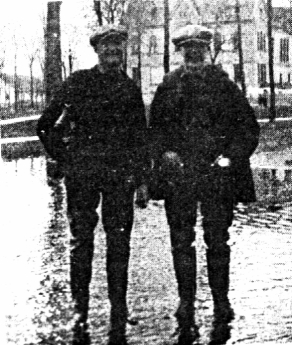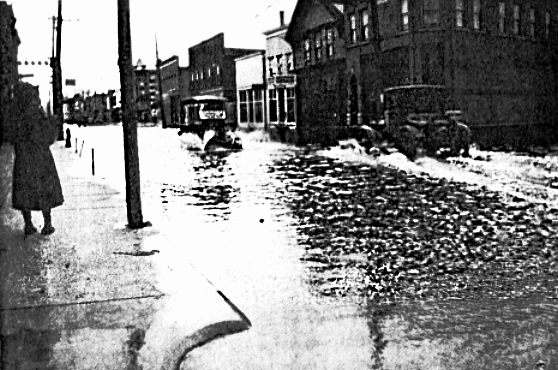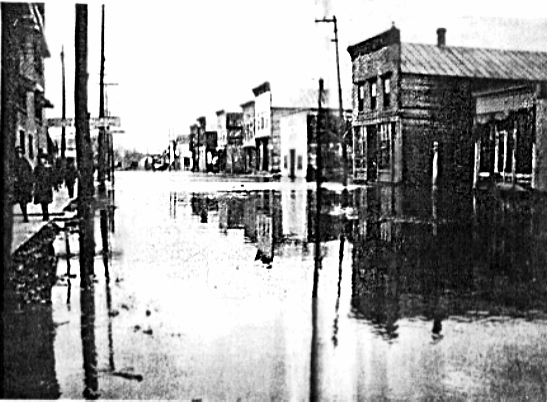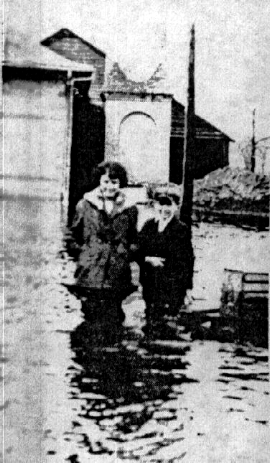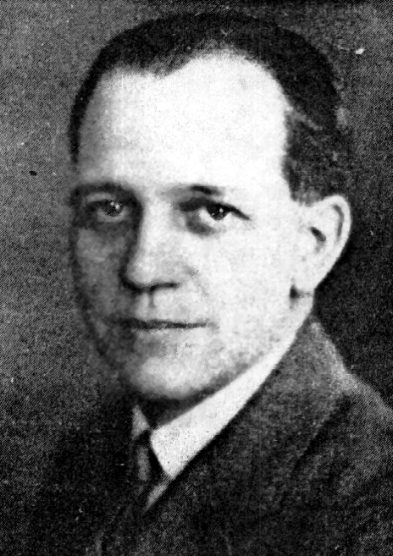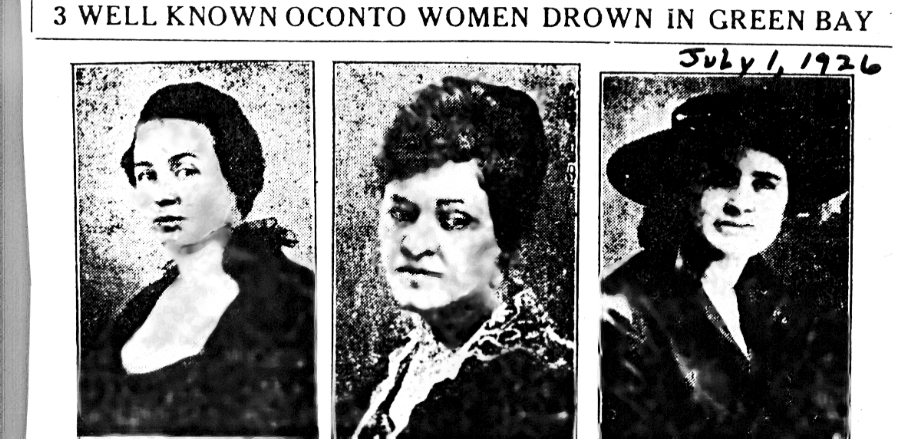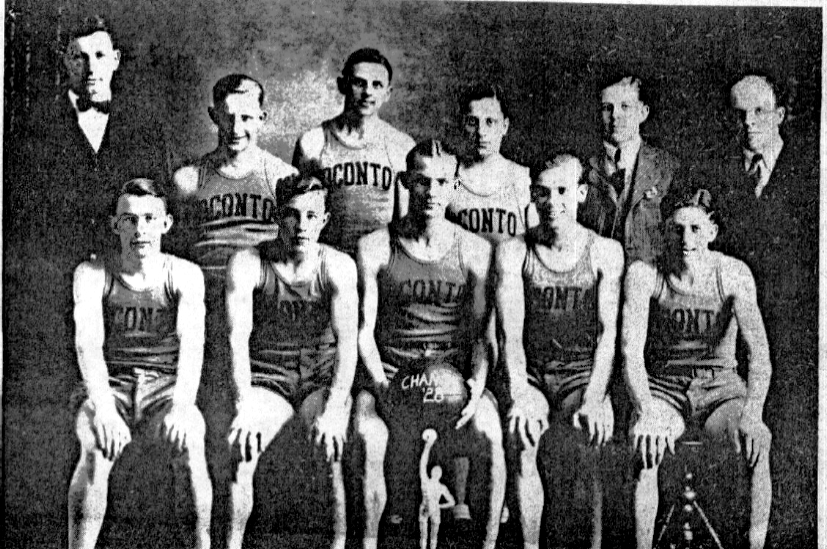| Oconto County Reporter
November 11, 1971 - Special Edition Contributed by Dave Cisler
A page in Oconto County history 1920-1929 Business Returning to Normal After Worst Flood in History
Oconto city is busy today drying herself out after the worst flood in the history of the city’s existence. Never before in the memory of man has the Oconto river emptied such a vast volume of water into the city limits. Citizens are anxiously peering down into dark, dank cellars at furnaces, and coal piles standing deep in the slowly receding river waters – or at wood piles now floating all over these same cellars. Merchants are at work cleaning up floors and re-arranging stocks in preparation for a return to normal business in the wake of the flood. Officials of the lumber companies are busy taking stock of the damage done which is pronounced slight. City officials spent considerable time this morning informing outside relief organizations that tents and relief supplies are NOT needed here. Students of the public and parochial schools were today
enjoying the last of the enforced vacation.
The Reporter-Enterprise was busy today getting out its regular weekly edition assembled under exceedingly trying circumstances, it must be admitted. Otherwise, Oconto city is little the worse for the wear and tear of the flood of the early part of this week. Fifteen to twenty families residing in the river district or in Frenchtown were returning today to their respective homes which they were forced to vacate last Monday in favor of the rising waters. These families, according to reports today, found little damage done outside of a general wetting of floors and basements. Train service direct to Green Bay from Oconto, without the detour via Gillett, was resumed this morning. Normal delivery of United States mail also began this morning with the return of the regular schedule of trains. The detour via Gillett puts mails behind time into this city. The flood looked bad on the face of it, Sunday, Monday
and Tuesday, but after the city had taken stock of itself today, it was
found that the damage was far less than had been anticipated.
A temporary dike was erected along Brazeau avenue, but the water topped this early Saturday. By Sunday Brazeau avenue was covered and the water began working its way through the city. Frenchtown was inundated and later the flood waters put in an appearance on Chicago avenue, Main street, Park avenue, Congress street and a dozen other streets south of Main. Hundreds of people came downtown Sunday afternoon to watch the swiftly rising waters. The demand for rubber boots far exceeded the local supply and calls were immediately dispatched to outside towns for boots. Downtown stores were opened Sunday afternoon and evening and a whirlwind business in rubber goods was done. This continued over Monday and Tuesday, but local merchants had to be content with the sale of boots in the absence of all other trade, due to the high water in the streets. Overcast skies on Sunday indicated rain, which arrived
on Monday. It poured all day, Monday, and local residents began to
realize then tat the high water would prevail for some time at least.
Monday night, a recession of the waters was noted, but on Tuesday the water
level began to rise. Tuesday noon, reports came from Oconto Falls
that there was danger of the dams going out at that place.
Such reports had been circulated as rumors here from Sunday afternoon on. Local city officials were in touch with Oconto Falls city officials at all times however and did not rely upon any rumors. Another danger point developed on Wednesday when a pile of logs owned by the Holt Lumber company tumbled into the river and swung down into one of the booms. A log jam at the Superior avenue bridge was threatened for a time, but the logs were soon gotten under control and were tied fast. Early Wednesday the river waters began to recede and
gradually went down during the night. When the city awoke this morning,
Main street was practically clear of water and but little water was reported
throughout the river district.
The lumber companies lost a quantity of lumber down river estimated at 50,000 feet. Outside of this loss, the damage to the company properties will be slight. Although business was practically suspended in the city Monday, Tuesday and Wednesday, a rapid return to normal is expected. None of the business houses suffered any great damage from the flood waters. The fifteen or twenty families in the river district were well taken care of by friends, and their homes were but slightly damaged, if at all. Railroad tracks in the lumber yards may be undermined, although this is not certain. The railroad companies report no particular damage to track or equipment as a result of the flood. School was dismissed on Monday when students found it impossible to get to the school houses. Most of the school houses had water in their basements, and some furniture was stored in Jefferson school, although no families took refuge there as stated in some of the papers. City streets may be damaged in spots, according to Chief of Police Smith. Brazeau avenue is washed out in some places. Some of the sidewalks have been torn up. There were heavy casualties among the rodent population of the city, there is no doubt of that. Rats by the hundreds were drowned in their holes, their bodies being later washed downriver. There may be some stock loses too. Public school will resume work next Tuesday morning. Vocational schools will resume at the regular house Tuesday afternoon. But a few basements over the city escaped being flooded. Temporary schemes for heating homes were arranged until the waters subsided. “It might have been worse,” is the optimistic-viewpoint taken by most of the local residents. Whether the flood will be an annual event is a question. According to the theories of some, it is thought that the high waters this year resulted directly from the building of drainage ditches over the county. Instead of heavy rains being held in check by swamps, the water is now immediately dumped into the river and a flood is the result. The matter will certainly bear investigation. Great credit must be accorded Fire Chief Harris who, with the aid of his men, has kept the river clear of ice jams this year. As soon as ice jams were threatened, they were at once dynamited. The value of such precautionary measures was apparent this week. SLABS AND EDGINGS October 21, 1920 – “Dauber” Drafz, Oconto, star hurler of the Menominee, Mich., baseball club, was purchased today by the Winnipeg team of the Canadian League. NOVEMBER 4, 1920 – At last the high school football team has broken the ice and won a game. After trying for four years, the school had its first victory by defeating the heavy Manitowoc team by a score of 28-0. * * * Seventy-five persons from Oconto Falls, most of them student basketball players and rooters, were imperiled Friday night when the passenger train on which they were returning from Shawano was struck head-on by a C&NW freight train five miles east of Shawano. FEBRUARY 9, 1922 – Forty men and 15 teams are employed to cut our ice supply. Herb Telford has a large gang at work four and one-half miles out on the bay. * * * The first woman jury to serve in Oconto county and the 20th judicial district was chosen this afternoon in the county court house. * * *
Leo Hidde has the only “wireless” telephony set in town. Hidde, although young in years, is fast becoming a master of the wonder of the age. He has perfected a wireless set – the only one in the city – to such a degree that he is now able to receive nightly programs from Chicago and Pittsburgh.
MARCH 23, 1922 – Lyle Steinhaus has purchased the store formerly owned by Olaf Gabrielson. * * *
* * * Three of Coach Melby’s stellar basketeers were chosen on the all-district team by Oshkosh Normal school. The three are Martineau, Flanders, and Runkel. AUGUST 3, 1922 – Another industrial plant, the Elmore Veneer Company, will be located in Oconto in the near future. SEPTEMBER 14, 1922 – Pahl Davis, Oconto, has signed up for a season with the Green Bay Packers, one of the most professional football teams in the entire country. During his high school years here, he was one of the stars of the local team. He plays this coming season with such players as Cub Buck, Jab Murray and Curly Lambeau. APRIL 6, 1922 – The work of fitting up the establishment formerly occupied by the Home Furnishing Company to suit the needs of the Home Bakery, of which M. Hoffman is proprietor, has already begun. APRIL 20, 1922 – Roland E. Stoelting, son of Dr. and Mrs. C. W. Stoelting, has been named commissioner of public works for the city of Milwaukee. * * * Clyde Davis, for the last two years head of the men’s department at Goodrich and Martineau, has resigned his position to become associated with Frank Lingelbach in the insurance business. FISHING IN 1922 May 4, 1922 – Twenty-two fishing boats, comprising Oconto’s fishing fleet, are being made ready for the spring and summer fishing season. One new boat, that of Will Burkhardt, will be added this year. Wesley Reed will launch his 40-footer to be used in freighting. Other fishermen who make up the fleet operating out of Oconto harbor are Elmer Olson, Emil Burkhardt, Charles Follett, Claflin Bros., O.R.Olson, Peter Moe, Earl Bostedt, Yens Hagfors, Otto Bostedt, Henry Frewerd, Carl Grosse, Ed Gerlack, Fred Wickenberg, Mike Valryg, Ed Johnson, Nels Templehull, Ed Groll, George Laxfors, Charles Zippel, Charles Skog and Peter Skog. MAY 1923 – The high school held a “May Fete” on the court house lawn one evening this week. Eunice Ansorge was elected Queen of the May and was attended by Evelyn Ansorge, Beatrice Cote, Helen Jane Duncan, Mae Porter, Myra Cashman, Bernice Roy, Marval Williams and Dorothy Menkee. Solo dances were done by Claire Bellew and Clymene Parisey, followed by Maypole dances by children from the Jefferson, Lincoln, Pecor and Washington schools on the four corners of the lawn. AUGUST 23, 1923 – Survey work on what promises to be the largest summer resort development program in the state was started this week, following the sale of 1,100 acres of land fronting on four different lakes in the district of northern Oconto county. This resort will be located around Wheeler Lake. Buyers from Chicago and Iowa have closed the deal with Charles Vogt, in charge of the sales department of the Oconto Company. * * * Oconto may some day become widely known as the home town of a number of great artists and famous musicians. Not long ago this paper carried an account of the musical success of the Richard twins in the west; now press clippings received at this office tell of the success of another Oconto girl, Claudine Jarvis, whose mother, Mr.S Anna Krueger, was well known in this city. Claudeine, 16, has been playing at the broadcasting station in Los Angeles. SEPTEMBER 20, 1923 – Members of the Clyde B. Jones post of the American Legion have decided to make the Legion hall a club for servicemen. DECEMBER 13, 1923 – In the large fish house at the turning basin dock, from 30 to 40 men were employed every day of the herring run, dressing, salting and packing fish for market. An average of about 20 tons of fresh fish were taken from the harbor here daily during the run. FEBRUARY 21, 1924 – “Babe” Fisher, guard on the Legion basketball team, was taken to the hospital with acute appendicitis. This ends Fisher’s playing for the rest of the season, but evidently he didn’t think so, for just as he was going under the ether, he began to wave his arms and yell: “I’m just making a basket, Doc! I’m just making a basket.” APRIL 3, 1924 – A new chapter has been written in the history of prohibition enforcement in Oconto. A man high in the profession with a clientele that includes many of the city’s “400” has found himself in the toils of the law. This history-making event took place Friday when P. K. O’Brien, shoe salesman, alias Jack M. Shafton, bootlegger, alighted from the train with 84 pints of liquor packed into two grips marked “shoes”. Chief of Police George Smith hauled O’Brien to Justice of the Peace Joseph Fisher and confiscated the booze. He claims to be a member of a large bootlegging ring with headquarters in Chicago. JULY 3, 1924 – The Standard Oil Company has purchases the lot on the corner of Superior avenue and Main street, which is now used as a park, and will erect upon it a filling station. Oconto will now have three filling stations – the Consumers Oil Corporation on the corner of Superior and School, and the Wadhams Oil station on the corner of Main and Michigan. JULY 1924 – The Kiwanis Club and the Chamber of Commerce have created a tourist campsite on the banks of the river on the east end of Main street, with stoves, wash tubs, water, wood, tent bottoms, caretaker and beach. JULY 31, 1924 – Company C, at two weeks encampment, was the largest company there and had the further distinction of representing the home town of General Wilbur Lee. One of the local men, Sgt. Ransom Rhode, made an enviable record in shooting, which places him in line for the Oconto team. OCTOBER 14, 1925 – Clinton DeWitt, treasurer of the Holt Hardwood Company, returned Sunday from a three months’ tour of Europe. He was accompanied by Eldred Klauser, who is now continuing his tour in a sailing vessel that will encircle the globe. THE LEMONY ONE
MARCH 1, 1926- A broken arch bar on an overloaded boxcar is thought to have been the cause of a St. Paul freight train wreck at the Stiles bridge Sunday night when five carloads of lumber and logs were piled into the Oconto river.
APRIL 29, 1926 – An option on 15,000 acres of land in the town of Wheeler was given this week by the Holt Lumber Company to Harry McCartney and associates of Chicago. The Chicago men, it is understood, will divide up this tract of land into hunting and fishing clubs, summer resorts and farms. AUGUST 19, 1926 – In an amphitheater of stately pines, birch and hemlock, with a canopy of great fluffs of white clouds drifting across a deep blue sky, the simple but impressive marriage of Mary Eleanor Holt, daughter of Mrs. and Mrs. W. A. Holt, to Donald Soule DeWitt was solemnized Saturday afternoon. * * * William Armstrong, son of Dr. and Mrs. C.E. Armstrong of this city, is gaining fame in the musical circles of the country. In a recent recital at Milwaukee he was hailed by critics as a coming Schipa. OCTOBER 14, 1926 –N. J. Gagnon has the distinction of being the first mortician in this part of the state to purchase one of the latest limousine hearses. MARCH 3, 1927 – The American Legion post will purchase the Modern Woodman building at a cash price of $5,200 as a Memorial Hall. OCTOBER 27, 1927 – Donald S. DeWitt has been appointed superintendent of Hold Lumber Company’s planning mill, in addition to his duties as superintendent of the Holt Hardwood Company mill. Since he designed the flooring plant of the latter company, he has become widely known and many people come here to see what is conceded to be a model hardwood flooring plant. JANUARY 19, 1928 – A hobby handed down to him by his aunt, who encouraged him to collect insects, has made possible one of the most complete collections of butterflies native to Wisconsin that can be found in museums of the state. Now, after eight years of collecting and exchanging, MacDonald Fulton, a senior at Carroll College, has donated his collection of more that 250 species to the biological department of Carroll. JANUARY 26, 1928 – A partnership was formed Friday between Frank Schneider and R. R. Uttormark of Seymour. Mr. Uttormark recently sold his store in Seymour and will move to Oconto. FEBRUARY 9, 1928 - The first carload of live
fish was shipped from Oconto Saturday morning by the Oconto Fish Company.
The fish were shipped in a special car which contained new water tanks.
The fish are taken from the “live boxes” in the river and placed in these
tanks. The water in the tanks is kept at the same temperature as
the river water by cakes of ice. The company ships three or four
tons of fish each day.
MAY 10, 1928 – Miss Gertrude Kehl, daughter of Mr. and Mrs. John Kehl, Little River, has been engaged as the first county nurse. MAY 1929 – That there is a possibility of Oconto county securing a 100,000-acre national forest preserve is the word from Washington. JULY 11, 1929 – Seven Cicero gangsters celebrated the Fourth of July in Sobieski and lived up to their reputation by staging a fight at the church picnic that resulted in many bruises and abrasions for the young men of Sobieski. Gusn, blackjacks and superior numbers proved too much for the Sobieski boys. FEBRUARY 28, 1929 – There is a scarlet fever epidemic in town and many doors are wearing the familiar red quarantine signs. APRIL 4, 1929 – Raymond Earle Mitchell, husband of the former Edith L. Steuer, Oconto, is gaining the reputation of being one of America’s foremost music composers. A group of his compositions, entitled “Scenes from Childhood”, was featured in a recent orchestra. His song, “Love is the Wind” was called by critics the best American song of the year. OCTOBER 24, 1929 – STORM LASHES BAY FOR $50,000 DAMAGE, DESTROYING EVERY NET IN BAY, UNDERMINING HOMES ALL ALONG THE SHORE AND RAISING THE BAY 30 INCHES. GALES OF 50 M.P.H. NOVEMBER 14, 1929 – The discovery of Indian mounds
in a stretch of small rolling hills in Oconto county, hitherto believed
unimportant pastureland, may open up one of the richest sections in the
state so far as archeological history is concerned, according to authorities
of the Milwaukee museum. In making a preliminary survey of the region,
the historians discovered a most unusual type of effigy mound. The
mounds had been made almost circular in shape, with a long extension or
trail. They are about five feet higher than the average mound found
in Wisconsin.
|
